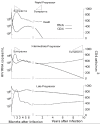Predictors of disease progression in HIV infection: a review
- PMID: 17502001
- PMCID: PMC1887539
- DOI: 10.1186/1742-6405-4-11
Predictors of disease progression in HIV infection: a review
Abstract
During the extended clinically latent period associated with Human Immunodeficiency Virus (HIV) infection the virus itself is far from latent. This phase of infection generally comes to an end with the development of symptomatic illness. Understanding the factors affecting disease progression can aid treatment commencement and therapeutic monitoring decisions. An example of this is the clear utility of CD4+ T-cell count and HIV-RNA for disease stage and progression assessment. Elements of the immune response such as the diversity of HIV-specific cytotoxic lymphocyte responses and cell-surface CD38 expression correlate significantly with the control of viral replication. However, the relationship between soluble markers of immune activation and disease progression remains inconclusive. In patients on treatment, sustained virological rebound to >10,000 copies/mL is associated with poor clinical outcome. However, the same is not true of transient elevations of HIV RNA (blips). Another virological factor, drug resistance, is becoming a growing problem around the globe and monitoring must play a part in the surveillance and control of the epidemic worldwide. The links between chemokine receptor tropism and rate of disease progression remain uncertain and the clinical utility of monitoring viral strain is yet to be determined. The large number of confounding factors has made investigation of the roles of race and viral subtype difficult, and further research is needed to elucidate their significance. Host factors such as age, HLA and CYP polymorphisms and psychosocial factors remain important, though often unalterable, predictors of disease progression. Although gender and mode of transmission have a lesser role in disease progression, they may impact other markers such as viral load. Finally, readily measurable markers of disease such as total lymphocyte count, haemoglobin, body mass index and delayed type hypersensitivity may come into favour as ART becomes increasingly available in resource-limited parts of the world. The influence of these, and other factors, on the clinical progression of HIV infection are reviewed in detail, both preceding and following treatment initiation.
Figures


References
-
- Fauci AS, Lane HC. Chapter 173. Human Immunodeficiency Virus Disease: AIDS and Related Disorders . In: Fauci AS, Lane HC, editor. Harrison's Principles of Internal Medicine. 16. Vol. 1. McGraw-Hill; 2005. pp. p1076–1139. (Harrison's Principles of Internal Medicine). Kasper Dennis L, Braunwald Eugene, Fauci Anthony S, Hauser Stephen L, Longo Dan L, Jameson J Larry, Isselbacher Kurt J.
-
- Murray PR, Rosenthal KS, Pfaller MA. Medical Microbiology. 5th. Vol. 1. Philadelphia, USA , Elsevier Mosby; 2005. p. 963.
-
- Miedema F. T cell dynamics and protective immunity in HIV infection: a brief history of ideas. Current Opinion in HIV & AIDS. 2006;1:1–2. - PubMed
-
- Osmond DH. In: Figure 1. Generalized time course of HIV infection and disease. HIV EDP, editor. HIV InSite Knowledge Base Chapter; 1998. pp. Modified from: Centers for Disease Control and Prevention. Report of the NIH Panel to Define Principles of Therapy of HIV Infection and Guidelines for the Use of Antiretroviral Agents in HIV–Infected Adults and Adolescents. MMWR 1998;47(No. RR-5):Figure 1, page 34 .
LinkOut - more resources
Full Text Sources
Other Literature Sources
Research Materials

